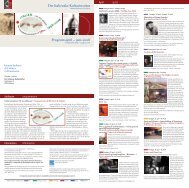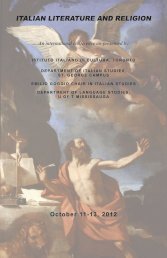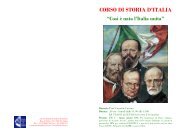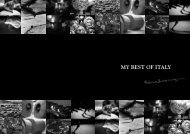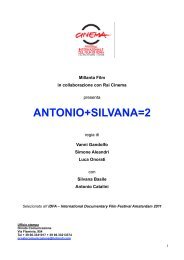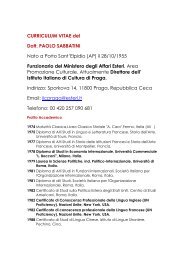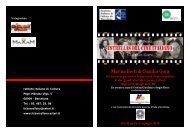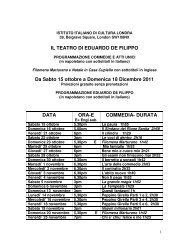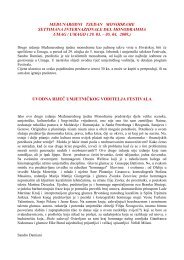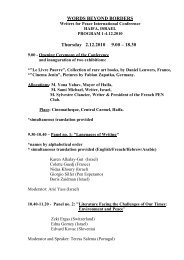Untitled - Ministero degli Affari Esteri
Untitled - Ministero degli Affari Esteri
Untitled - Ministero degli Affari Esteri
Create successful ePaper yourself
Turn your PDF publications into a flip-book with our unique Google optimized e-Paper software.
cadute». Congiuntamente Angela si serve<br />
dell’acquaforte, della possibilità che i tempi<br />
della morsura le offrono di modulare la<br />
superficie attraverso il gioco dei valori tonali<br />
che graduano il blu con il quale sono tinte<br />
le sue calotte celesti.<br />
Poi vi interviene con l’acquatinta affiancando<br />
alla profondità dei solchi, ai segni minuti<br />
delle scritture, la vaporosità della macchia<br />
pittorica sgranatamene evocativa di aeree<br />
ed infinite dilatazioni che crescono nella<br />
profondità azzerante e vellutata della notte<br />
per via dell’intervento della maniera nera<br />
o mezzotinto. È una summa di alchimie<br />
la sua che apre il passo ad un intenzionale<br />
ed annunciato muovere tra esse.<br />
Esclusivamente all’acquaforte si devono<br />
le immagini di Isabella Ciaffi, di Luigi<br />
Marcon, di Bruno Canova e di Ines Merola.<br />
Ciascuno ha fatto tesoro delle peculiarità<br />
di questo “linguaggio” espressivo per dar<br />
vita a quelle pagine narrative, esiti mai<br />
finali, che testimoniano della conoscenza<br />
del mezzo. Si va dal segno regolare e<br />
descrittivo di Marcon che impiega l’azione<br />
dell’acido per disegnare piani e volumi,<br />
accentuare contrasti chiaroscurali, parlare<br />
insomma di una Ravello colta con il taglio<br />
di un occhio quasi fotografico, fedele al<br />
dato di una realtà rinnovata alla luce di un<br />
autonomo bianco e nero, alle pagine della<br />
Ciaffi, dedita, nella sua lunga esperienza<br />
di incisore, quasi esclusivamente a questa<br />
tecnica. L’acquaforte è per Isabella dosare<br />
innanzitutto il rapporto con la lastra<br />
inchiostrata, cominciare con il depositare<br />
in essa un segno e poi tanti segni<br />
assecondando gesti energici ed incalzanti,<br />
fino quasi a coprire la superficie, lasciando<br />
però calcolati e consapevoli margini alla luce.<br />
Inseguire in sostanza un’immagine o meglio<br />
la sensazione di tale immagine è per l’artista<br />
inseguire le traccie di un gesto, in armonia<br />
con le potenzialità del mezzo. Un’armonia<br />
che Bruno Canova raggiunge aggiungendovi<br />
la seduzione del colore, quasi una cornice<br />
decorativa come un omaggio alla natura<br />
lasciata sulla carta come impronta leggera<br />
black manner or mezzo-tint. It is a summa<br />
of alchemies that opens the way to an<br />
intentional movement among them.<br />
Isabella Ciaffi, Luigi Marcon, Bruno Canova<br />
and Ines Merola only use etchings for their<br />
images. Each one of them has treasured the<br />
characteristics of this expressive “language”<br />
to give life to those narrative pages, without<br />
a final outcome, that bear witness to their<br />
knowledge of the medium. From Marcon’s<br />
smooth descriptive sign that uses acid to<br />
draw planes and volumes and accentuate<br />
chiaroscuro contrasts, to talk about a Ravello<br />
caught by an almost photographic eye,<br />
true to a renewed reality in the light of an<br />
autonomous black and white, to Ciaffi’s<br />
pages, who has dedicated herself almost<br />
exclusively to this technique during her long<br />
experience as an etcher.<br />
For Isabella, etching is first of all calculating<br />
the relationship with the inked plate,<br />
starting with one sign and then many signs,<br />
with energetic and insistent movements<br />
until almost covering the surface,<br />
but leaving calculated margins of light.<br />
Pursuing an image, or rather the feeling<br />
of that image, is, for the artist, pursuing<br />
the tracks of a gesture, in harmony with<br />
the potential of the medium. Bruno Canova<br />
reaches this harmony adding the appeal<br />
of colour, almost a decorative frame<br />
as a gift to nature left on the paper like a<br />
light print that borders perspectives cut like<br />
photograms restored to memory.<br />
For them he gauges the etchings, looking<br />
for the value of the light that cloaks such<br />
compositions in a metaphysical astanza<br />
using smooth, close lines. Merola applies<br />
a few gauged lines to obtain smooth<br />
drawings. It is a kind of expressive<br />
minimalism that relies on cursively wavy<br />
or rigidly cut lines to reconstruct an image<br />
or rather, a space and the elements that<br />
form it. As a new etcher, Ines contends with<br />
the plate, etching times and the choice<br />
of chalcographic ink enclosing the sense<br />
of evocative visions in the essentiality<br />
of silver atmospheres.<br />
27



